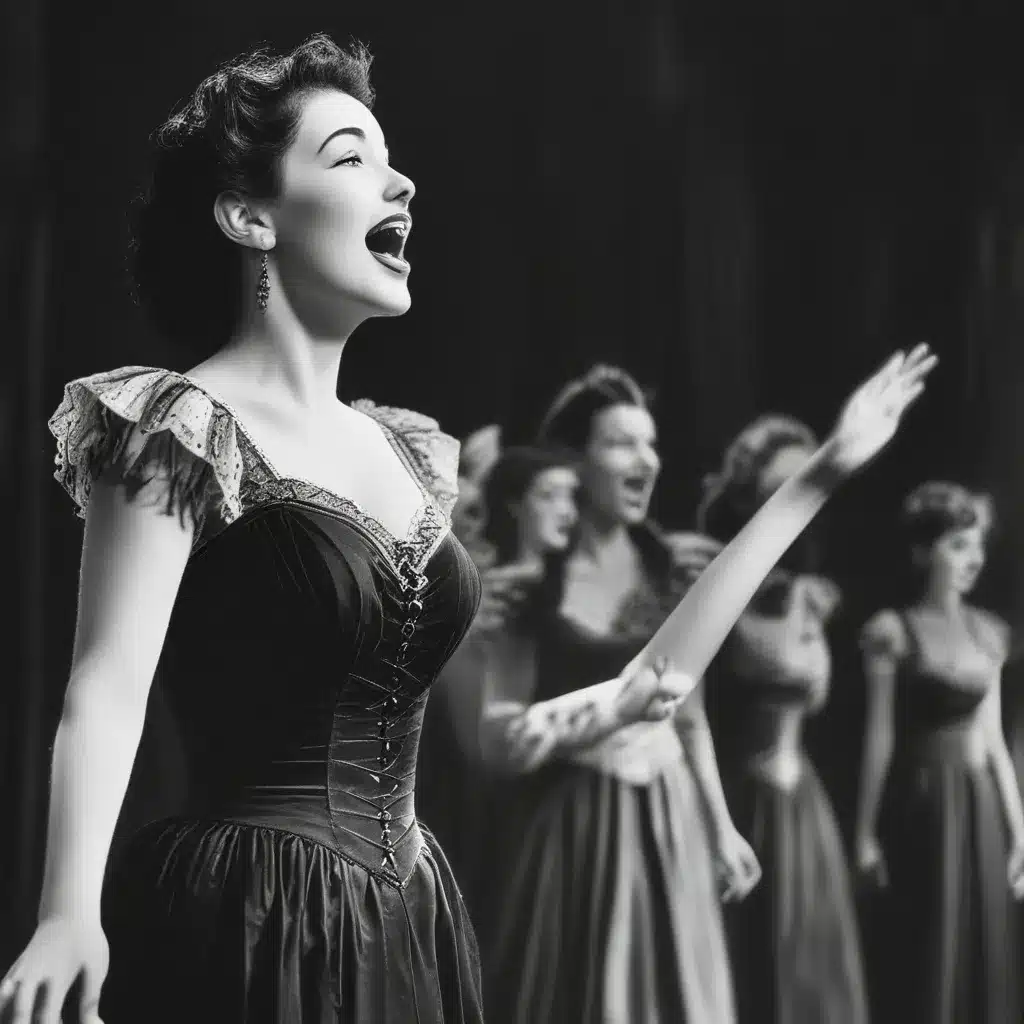
The Legit Soprano Reigns Supreme (1900-1930)
As I step onto the stage of the musical theater education and performance center, the energy of the space electrifies me. I can almost feel the ghosts of Broadway legends past – the powerful legit sopranos who once graced these boards, their crystal-clear voices filling the air with operatic grandeur.
In the early 20th century, the musical theater landscape was dominated by classically-trained vocalists. Prior to 1930, belt singing was confined to character roles, while the leading ladies were expected to possess the tall, round vowels and steady vibrato of the opera singer. These ladies, like the incomparable Shirley Jones or the legendary Julie Andrews, captivated audiences with their effortless vocal virtuosity, their voices soaring through the theater without the aid of microphones.
But the winds of change were starting to blow, as a young upstart named Ethel Merman was about to turn the Broadway vocal landscape on its head. On October 14, 1930, Merman burst onto the scene in George Gershwin’s “Girl Crazy”, wowing the crowd with her brassy, trumpet-like belt that could sustain a high C over a full orchestra. Gershwin was so impressed, he told Merman, “Don’t ever let anyone give you a singing lesson – it’ll ruin you!”
Suddenly, the legit soprano was no longer the be-all and end-all of Broadway vocalism. Songwriters began writing in lower tessituras to showcase this new, more speech-like style of singing, paving the way for the rise of the “singer-actress” – ladies like Mary Martin and Celeste Holm, who could seamlessly blend legit and belt techniques to serve the character.
The Golden Age of Broadway (1943-1964)
It was during the Golden Age of Broadway, from 1943 to 1964, that the musical theater voice truly came into its own. While the legit sopranos still reigned supreme, they now shared the stage with a new breed of leading lady – the belters and mixers, who used their vocal power and flexibility to convey the inner life of their characters.
| Legit Sopranos | Belters/Mixers |
|---|---|
| Julie Andrews | Ethel Merman |
| Barbara Cook | Mary Martin |
| Shirley Jones | Celeste Holm |
No longer were the days of pure vocal flourish and bel canto prowess – instead, the ability to convey character through one’s singing became the new standard. A legit soprano like Barbara Cook might bring the same round, vibrant tone to a role as a powerhouse belter like Ethel Merman, but the way they used that voice would be entirely different. Vocal strength and flexibility, not just beautiful singing, were now the keys to success on the Broadway stage.
This evolution was due in no small part to the introduction of the microphone. Prior to the 1930s, only the opera singers, legit singers, and belters could fill a theater without amplification. But as orchestrations became heavier and audiences demanded a softer, more intimate vocal style (think Bing Crosby and Frank Sinatra), the microphone became a necessity.
Suddenly, a performer’s ability to project was no longer the primary concern. Instead, they could focus on nuanced, character-driven vocals – the kind that could make the audience lean in and hang on every word. The legit soprano remained a powerful force, but she now shared the stage with a new generation of leading ladies who used their voices to tell a story.
The Rise of the Pop/Rock Vocalist (1960s-Present)
As the curtain rose on the 1960s, a seismic shift was about to occur in the world of musical theater vocalism. The arrival of shows like “Promises, Promises” and “Hair” signaled the beginning of a new era – one where the traditional Broadway sound would be challenged by the raw, unapologetic power of pop and rock.
These new musicals did not immediately upend the established order. The legit sopranos and belters of the Golden Age still held sway, their voices ringing out across the footlights. But a subtle change was starting to take hold, as the theatrical landscape began to embrace a more youthful, energetic sound.
Suddenly, the ability to belt was no longer enough. Performers were expected to navigate the soulful runs and gritty growls of rock, all while maintaining the stamina and stage presence of a seasoned Broadway veteran. And as the decades passed, this new vocal style would only continue to evolve, incorporating elements of R&B, pop, and even electronic music.
Today, as I step onto the stage of the Musical Theater Center, I can feel the echoes of those who have come before me. The legit sopranos, the powerhouse belters, the rock-infused vocalists – they’ve all left their mark on this hallowed ground. And as I open my mouth to sing, I know that I’m carrying on a tradition that stretches back decades, a tradition that has evolved and transformed with each passing generation.
It’s a humbling thought, but also an exhilarating one. Because the voice of the Broadway musical is ever-changing, ever-adapting to the needs of the time. And who knows what the future might hold? All I know is that I’m excited to be a part of it, to add my own unique twist to this enduring legacy. So let’s raise our voices together and see where the journey takes us next!

